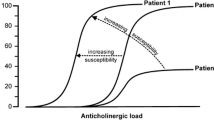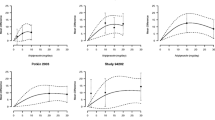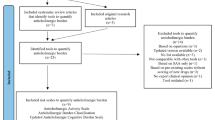Abstract
Purpose
To quantify pharmacokinetic (PK) and pharmacodynamic (PD) relationships of various classes of GABAA agonists in healthy volunteers, in order to investigate the sensitivity of the biomarker responses due to differing GABAA-subtype selectivity and to explore the correlation between biomarker responses and side effects of these drugs.
Methods
A comprehensive search was conducted for published placebo-controlled clinical studies of non- and α1-selective GABAA drugs in healthy volunteers. PK/PD models were developed for concentrations and biomarker outcomes (saccadic eye movement (SEM), visual analogue scale (VAS), digit symbol substitution task (DSST), and critical flicker fusion test (CFFT)) extracted from included studies. Predicted responses and equivalent doses for biomarkers (based on predicted response) were used to compare drug effects. And the relationship between biomarkers and safety was explored by linear regression.
Results
A total of 2237 data from 163 articles were included. Based on PK and placebo effect modeling, linear biomarker-concentration relationships well fit the data. The α1-selective compounds had similar equivalent doses for VAS, DSST, and CFFT (4.7–6.7 mg), which were about three to seven times lower than that for SEM (14.4–35.5 mg), while such difference was less evident for non-selective drugs. DSST had the highest correlations with incidences of somnolence and dizziness.
Conclusions
The integral PK/PD models of GABAA agonists were established in healthy volunteers. SEM was identified as the most sensitive biomarker in differentiating GABAA receptor α1 subtype selective compounds. The exploratory analysis implied that different relationships existed between the drug effects on biomarkers and the adverse event profiles in healthy volunteers.





Similar content being viewed by others
References
Rudolph U, Knoflach F (2011) Beyond classical benzodiazepines: novel therapeutic potential of GABAA receptor subtypes. Nat Rev Drug Discov 10(9):685–697
Dell’Osso B, Lader M (2013) Do benzodiazepines still deserve a major role in the treatment of psychiatric disorders? A critical reappraisal. Eur Psychiatry 28(1):7–20
McKernan RM, Rosahl TW, Reynolds DS et al (2000) Sedative but not anxiolytic properties of benzodiazepines are mediated by the GABA(A) receptor alpha1 subtype. Nat Neurosci 3(6):587–592
Rudolph U, Crestani F, Benke D et al (1999) Benzodiazepine actions mediated by specific gamma-aminobutyric acid(A) receptor subtypes. Nature 401(6755):796–800
Low K, Crestani F, Keist R et al (2000) Molecular and neuronal substrate for the selective attenuation of anxiety. Science 290(5489):131–134
Rudolph U, Crestani F, Mohler H (2001) GABA(A) receptor subtypes: dissecting their pharmacological functions. Trends Pharmacol Sci 22(4):188–194
Morris HV, Dawson GR, Reynolds DS et al (2006) Both alpha2 and alpha3 GABAA receptor subtypes mediate the anxiolytic properties of benzodiazepine site ligands in the conditioned emotional response paradigm. Eur J Neurosci 23(9):2495–2504
Dias R, Sheppard WF, Fradley RL et al (2005) Evidence for a significant role of alpha 3-containing GABAA receptors in mediating the anxiolytic effects of benzodiazepines. J Neurosci 25(46):10682–10688
Atack JR, Hutson PH, Collinson N et al (2005) Anxiogenic properties of an inverse agonist selective for alpha3 subunit-containing GABA a receptors. Br J Pharmacol 144(3):357–366
Crestani F, Keist R, Fritschy JM et al (2002) Trace fear conditioning involves hippocampal alpha5 GABA(A) receptors. Proc Natl Acad Sci U S A 99(13):8980–8985
Collinson N, Kuenzi FM, Jarolimek W et al (2002) Enhanced learning and memory and altered GABAergic synaptic transmission in mice lacking the alpha 5 subunit of the GABAA receptor. J Neurosci 22(13):5572–5580
Atack JR (2011) GABAA receptor subtype-selective modulators. II. Alpha5-selective inverse agonists for cognition enhancement. Curr Top Med Chem 11(9):1203–1214
Mohler H, Crestani F, Rudolph U (2001) GABA(A)-receptor subtypes: a new pharmacology. Curr Opin Pharmacol 1(1):22–25
O’Brien CP (2005) Benzodiazepine use, abuse, and dependence. J Clin Psychiatry 66 Suppl 2(6):28–33
Dämgen K, Lüddens H (1999) Zaleplon displays a selectivity to recombinant GABAA receptors different from zolipdem, zopiclone and benzodiazepines. Neurosci Res Commun 25(3):139–148
Petroski RE, Pomeroy JE, Das R et al (2006) Indiplon is a high-affinity positive allosteric modulator with selectivity for alpha1 subunit-containing GABAA receptors. J Pharmacol Exp Ther 317(1):369–377
Montplaisir J, Hawa R, Moller H et al (2003) Zopiclone and zaleplon vs benzodiazepines in the treatment of insomnia: Canadian consensus statement. Hum Psychopharmacol 18(1):29–38
Israel AG, Kramer JA (2002) Safety of zaleplon in the treatment of insomnia. Ann Pharmacother 36(5):852–859
de Haas SL, de Visser SJ, van der Post JP et al (2007) Pharmacodynamic and pharmacokinetic effects of TPA023, a GABA(A) alpha(2,3) subtype-selective agonist, compared to lorazepam and placebo in healthy volunteers. J Psychopharmacol 21(4):374–383
de Haas SL, de Visser SJ, van der Post JP et al (2008) Pharmacodynamic and pharmacokinetic effects of MK-0343, a GABA(A) alpha2,3 subtype selective agonist, compared to lorazepam and placebo in healthy male volunteers. J Psychopharmacol 22(1):24–32
de Haas SL, Franson KL, Schmitt JA et al (2009) The pharmacokinetic and pharmacodynamic effects of SL65.1498, a GABA-A alpha2,3 selective agonist, in comparison with lorazepam in healthy volunteers. J Psychopharmacol 23(6):625–632
Atack JR, Hallett DJ, Tye S et al (2011) Preclinical and clinical pharmacology of TPA023B, a GABAA receptor α2/α3 subtype-selective partial agonist. J Psychopharmacol 25(3):329–344
Rudolph U, Mohler H (2006) GABA-based therapeutic approaches: GABAA receptor subtype functions. Curr Opin Pharmacol 6(1):18–23
Vinkers CH, Olivier B (2012) Mechanisms underlying tolerance after long-term benzodiazepine use: a future for subtype-selective GABA(A) receptor modulators? Adv Pharmacol Sci 2012:416864
de Visser SJ, van der Post JP, de Waal PP et al (2003) Biomarkers for the effects of benzodiazepines in healthy volunteers. Br J Clin Pharmacol 55(1):39–50
Chen X, de Haas S, de Kam M et al (2012) An overview of the CNS-Pharmacodynamic profiles of nonselective and selective GABA agonists. Adv Pharmacol Sci 2012:134523
de Haas SL, Schoemaker RC, van Gerven JM et al (2010) Pharmacokinetics, pharmacodynamics and the pharmacokinetic/pharmacodynamic relationship of zolpidem in healthy subjects. J Psychopharmacol 24(11):1619–1629
Gupta SK, Ellinwood EH, Nikaido AM et al (1990) Simultaneous modeling of the pharmacokinetic and pharmacodynamic properties of benzodiazepines. I: Lorazepam. J Pharmacokinet Biopharm 18(2):89–102
Venkatakrishnan K, Culm KE, Ehrenberg BL et al (2005) Kinetics and dynamics of intravenous adinazolam, N-desmethyl adinazolam, and alprazolam in healthy volunteers. J Clin Pharmacol 45(5):529–537
Mould DR, DeFeo TM, Reele S et al (1995) Simultaneous modeling of the pharmacokinetics and pharmacodynamics of midazolam and diazepam. Clin Pharmacol Ther 58(1):35–43
van Steveninck AL, Schoemaker HC, Pieters MS et al (1991) A comparison of the sensitivities of adaptive tracking, eye movement analysis and visual analog lines to the effects of incremental doses of temazepam in healthy volunteers. Clin Pharmacol Ther 50(2):172–180
Kamal MA, Smith DE, Cook J et al (2010) Pharmacodynamic differentiation of lorazepam sleepiness and dizziness using an ordered categorical measure. J Pharm Sci 99(8):3628–3641
Garcia-Gea C, Ballester MR, Martinez J et al (2010) Rupatadine does not potentiate the CNS depressant effects of lorazepam: randomized, double-blind, crossover, repeated dose, placebo-controlled study. Br J Clin Pharmacol 69(6):663–674
Farber RH, Burke PJ (2008) Post-bedtime dosing with indiplon in adults and the elderly: results from two placebo-controlled, active comparator crossover studies in healthy volunteers. Curr Med Res Opin 24(3):837–846
Lucchesi LM, Braga NI, Manzano GM et al (2005) Acute neurophysiological effects of the hypnotic zolpidem in healthy volunteers. Prog Neuropsychopharmacol Biol Psychiatry 29(4):557–564
Hou RH, Scaife J, Freeman C et al (2006) Relationship between sedation and pupillary function: comparison of diazepam and diphenhydramine. Br J Clin Pharmacol 61(6):752–760
Hoever P, de Haas S, Winkler J et al (2010) Orexin receptor antagonism, a new sleep-promoting paradigm: an ascending single-dose study with almorexant. Clin Pharmacol Ther 87(5):593–600
Dixon R, Hughes AM, Nairn K et al (1998) Effects of the antimigraine compound zolmitriptan (‘Zomig’) on psychomotor performance alone and in combination with diazepam in healthy volunteers. Cephalalgia 18(7):468–475
Hege SG, Ellinwood EJ, Wilson WH et al (1997) Psychomotor effects of the anxiolytic abecarnil: a comparison with lorazepam. Psychopharmacology (Berl) 131(2):101–107
Vermeeren A, Jackson JL, Muntjewerff ND et al (1995) Comparison of acute alprazolam (0.25, 0.50 and 1.0 mg) effects versus those of lorazepam 2 mg and placebo on memory in healthy volunteers using laboratory and telephone tests. Psychopharmacology (Berl) 118(1):1–9
Gomeni R, Merlo-Pich E (2007) Bayesian modelling and ROC analysis to predict placebo responders using clinical score measured in the initial weeks of treatment in depression trials. Br J Clin Pharmacol 63(5):595–613
Goyal N, Gomeni R (2013) A latent variable approach in simultaneous modeling of longitudinal and dropout data in schizophrenia trials. Eur Neuropsychopharmacol 23(11):1570–1576
Nucci G, Gomeni R, Poggesi I (2009) Model-based approaches to increase efficiency of drug development in schizophrenia: a can’t miss opportunity. Expert Opin Drug Discov 4(8):837–856
Beal SL, Sheiner LB, Boeckmann AJ. NONMEM User’s Guide – Part I–VII. Ellicott City, MD: Icon Development Solutions. ed.: 1989–2006.
Keizer RJ, van Benten M, Beijnen JH et al (2011) Pirana and PCluster: a modeling environment and cluster infrastructure for NONMEM. Comput Methods Programs Biomed 101(1):72–79
Lindbom L, Ribbing J, Jonsson EN (2004) Perl-speaks-NONMEM (PsN)—a Perl module for NONMEM related programming. Comput Methods Programs Biomed 75(2):85–94
Sieghart W (1995) Structure and pharmacology of gamma-aminobutyric acidA receptor subtypes. Pharmacol Rev 47(2):181–234
Pritchett DB, Luddens H, Seeburg PH (1989) Type I and type II GABAA-benzodiazepine receptors produced in transfected cells. Science 245(4924):1389–1392
Bond A, Lader M (1974) The use of analogue scales in rating subjective feelings. Br J Med Psychol 47(3):211–218
Zuo XC, Zhang BK, Jia SJ et al (2010) Effects of Ginkgo biloba extracts on diazepam metabolism: a pharmacokinetic study in healthy Chinese male subjects. Eur J Clin Pharmacol 66(5):503–509
Barbanoj MJ, Urbano G, Antonijoan R et al (2007) Different acute tolerance development to EEG, psychomotor performance and subjective assessment effects after two intermittent oral doses of alprazolam in healthy volunteers. Neuropsychobiology 55(3–4):203–212
Tornio A, Neuvonen PJ, Backman JT (2006) The CYP2C8 inhibitor gemfibrozil does not increase the plasma concentrations of zopiclone. Eur J Clin Pharmacol 62(8):645–651
Carlson JN, Haskew R, Wacker J et al (2001) Sedative and anxiolytic effects of zopiclone’s enantiomers and metabolite. Eur J Pharmacol 415(2–3):181–189
Saari TI, Laine K, Bertilsson L et al (2007) Voriconazole and fluconazole increase the exposure to oral diazepam. Eur J Clin Pharmacol 63(10):941–949
Hall J, Naranjo CA, Sproule BA et al (2003) Pharmacokinetic and pharmacodynamic evaluation of the inhibition of alprazolam by citalopram and fluoxetine. J Clin Psychopharmacol 23(4):349–357
Caille G, du Souich P, Spenard J et al (1984) Pharmacokinetic and clinical parameters of zopiclone and trimipramine when administered simultaneously to volunteers. Biopharm Drug Dispos 5(2):117–125
Smith AJ, Alder L, Silk J et al (2001) Effect of alpha subunit on allosteric modulation of ion channel function in stably expressed human recombinant gamma-aminobutyric acid(A) receptors determined using (36)Cl ion flux. Mol Pharmacol 59(5):1108–1118
Patat A, Perault MC, Vandel B et al (1995) Assessment of the interaction between a partial agonist and a full agonist of benzodiazepine receptors, based on psychomotor performance and memory, in healthy volunteers. J Psychopharmacol 9(2):91–101
Acknowledgments
The authors gratefully acknowledge support from Dr. Guangli Ma [Pfizer (China) Research and Development Center]. This work was sponsored by Pfizer Inc.
Conflict of interest
The authors declare that they have no conflict of interest.
Author information
Authors and Affiliations
Corresponding author
Electronic supplementary material
Below is the link to the electronic supplementary material.
ESM 1
(PDF 1324 kb)
Rights and permissions
About this article
Cite this article
Ren, YP., Xie, RJ., Marshall, S. et al. Model-based meta-analysis of the effects of non-selective and α1-selective GABAA receptor agonists in healthy volunteers. Eur J Clin Pharmacol 71, 1209–1221 (2015). https://doi.org/10.1007/s00228-015-1918-8
Received:
Accepted:
Published:
Issue Date:
DOI: https://doi.org/10.1007/s00228-015-1918-8




